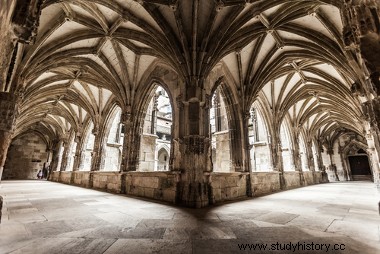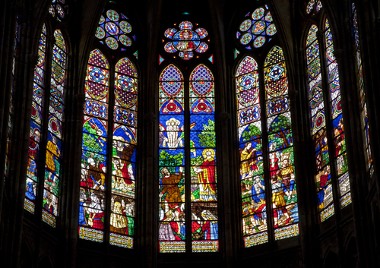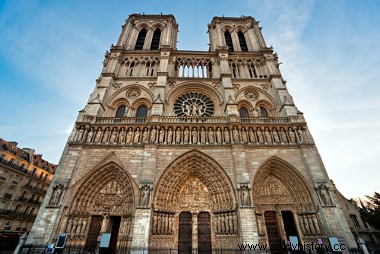
By Me. Tales Pinto
In the late period of the so-called Middle Ages, around the end of the twelfth century, a new architectural style emerged in the north of the European continent, more precisely in the north of France:the gothic architecture . Characterized by the sumptuousness of the buildings, linked to the religious character of the style, Gothic architecture expanded to a large part of the continent in later centuries.
Gothic architecture was developed from buildings in the Romanesque style, which was very popular in the past. Romanesque architecture was characterized by rounded vaults supported by semicircular arches. Due to these characteristics, the Romanesque constructions needed heavy and large structures to remain standing. The thick stone pillars ensured this support, but limited the height of the buildings and made it difficult for light to enter, due to the need to maintain the walls.

Inside view of the cathedral in Cahors, France, where you can see the ogival arch structures
To overcome this limitation, the Norman architects who initially developed Gothic architecture developed a technique that made structures lighter. It should be noted that such architectural styles were mainly developed for the construction of Catholic religious temples. In the case of Gothic architecture, construction took place mainly in cathedrals, the bishops' own churches (cathedra means bishop's throne ).
Unlike Romanesque architecture, Gothic style architects developed pointed vaults , which gave a greater dimension to the central and lateral naves of the cathedrals. To support them, arches were built to support the vaults, not in the shape of a semicircle, but pointed arches , formed from the junction of two segments of circles. This innovation made it possible to increase the height of the buildings, as the technique allowed for greater flexibility in size.
To support these arches, the large supporting columns were no longer needed. It was possible to obtain support with thinner columns, formed by ribs and stone beams that gave a greater sense of lightness to the construction. In addition to these lighter support structures, so-called archobutants were developed on the external walls, used to support the weight of the vault of the central nave over the ceilings of the side aisles.

Stained glass windows of the Saint-Denis cathedral in France, the first to be built following Gothic architecture
These innovations made it possible to remove most of the side walls and replace them with windows that were adorned with beautiful stained glass . This measure also allowed the entry of light into the environment, giving a new appearance to the religious temples, mainly because not only the white light of the sun, but also other colors resulting from the passage through the windows. Another characteristic stained glass window of Gothic cathedrals were the rose windows placed over the entrance gates of the temples.
Sculptures were also built and placed on the porticoes of the cathedrals. The sculptures differed from Romanesque-style sculptures in that they are not so solid, but rather come to life.
The height and sumptuousness of the constructions conveyed a sense of diminution of the human being in these places. The towers with a greater vertical projection also served as a reverence for God, as they were directed to the heavens. Some of the buildings had the shape of the Latin cross, perceptible from a top view of the building.
The first Gothic cathedral was that of Saint-Denis, France. The most famous is Notre-Dame Cathedral in Paris. The term Gothic was coined possibly by Giorgio Vassari (1511-1574), during the Renaissance, as a pejorative way to compare it to the classical style. Gothic was considered a barbaric, “monstrous” style, whose name was derived from the Goths. However, from the 18th century onwards, there was a process of reassessment of the style, initially in England and later in France, Germany and Italy.

Notre-Dame Cathedral in Paris. The most famous of the cathedrals built following Gothic architecture
